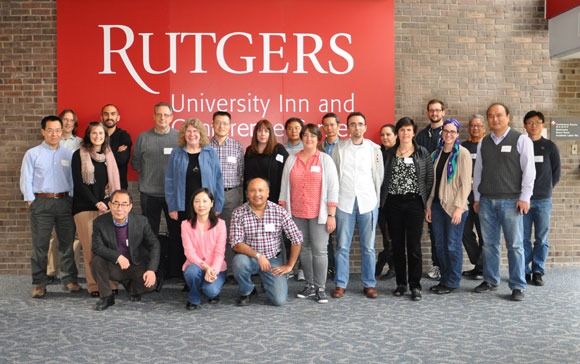Comparative genomic approaches to understanding
the evolution of Magnaporthales *
Jan. 7, 2016
8:30-8:40 Welcome: Bradley Hillman, Bruce Clarke
8:40 Introduction: Debashish Bhattacharya and Ning Zhang
8:45 Ning Zhang, Rutgers University
Phylogenomic analysis of Magnaporthales
9:00 Barbara Valent, Kansas State University
Ancient and emerging threats to food security from the Magnaporthales
9:15 Pierre Gladieux, Cirad-Bios, France
Population genomics of endemic and pandemic lineages of the rice blast fungus
9:30 Chang-Hyun Khang, University of Georgia
Identification and distribution of effector gene homologs in Magnaporthales
9:45 Darren Soanes, University of Exeter, UK
Resequencing of Magnaporthe genomes reveals uneven distribution of secondary metabolic clusters
10:00-10:15 Coffee break, B/C Lndg
10:15 Yong-Hwan Lee, Seoul National University, Korea
Comparative analysis of effector candidates in Magnaporthales
10:30 Jin-Rong Xu, Purdue University
10:45 Marc-Henri LeBrun, Directeur Ur Bioger, France
Resolving the polyphyletic nature of Pyricularia (Pyriculariaceae)
11:00 Barbara Robbertse, RefSeq, NCBI
While reviewing fungal genomes – trust but verify
11:15 Huan Qiu, Rutgers University
Massive recent horizontal transfer between fungi of genes involved in plant pathogenesis
11:30 Jennifer Wisecaver, Vanderbilt University
Detection of secondary metabolic gene clusters and horizontal gene transfer in Magnaporthales genome assemblies
11:45 Jo Anne Crouch, USDA ARS.
Evolutionary forces shaping the region surrounding MAT1 across the Magnaporthales
12:00 Nicole Donofrio, University of Delaware
The fine line of host range: Initial studies into comparisons between two Magnaporthe oryzae strains
Marc-Henri LeBrun on behalf of Elisabeth Fournier
Deciphering genome content and evolutionary relationships of isolates from the fungus Magnaporthe (Pyricularia) oryzae attacking different host plants
Ralph Dean, North Carolina State University
Identification and functional characterization of Magnaporthe effectors
* Supported by the National Science Foundation
Rutgers School of Environmental and Biological Sciences, and Rutgers Center for Turfgrass Science
The conference was held at the Rutgers University Inn and Conference Center

